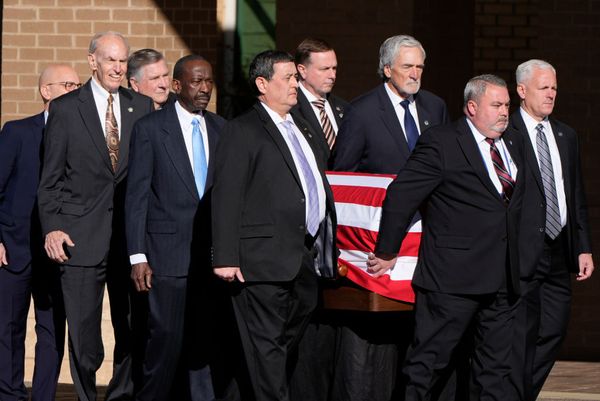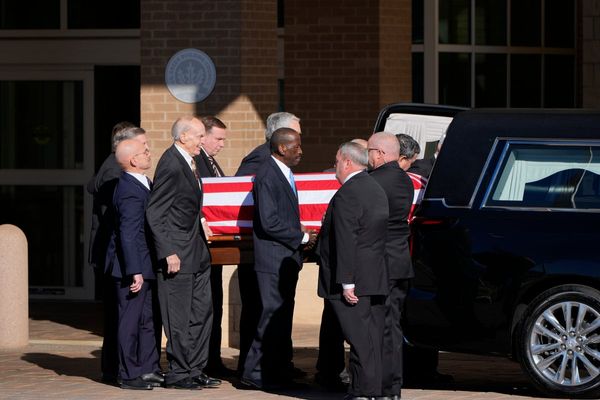
In the free-flowing 1970s, Guy Lafleur raised heart rates and brought fans out of their seats.
On Friday, those hearts were heavy after the Montreal Canadiens’ announcement that Lafleur has died. He was 70.
A five-time Stanley Cup winner with Montreal, Lafleur will be most remembered for his electric rushes down the right wing at the old Montreal Forum, hair flowing behind him as he wound up for a shot.
One of the NHL’s top scorers during a period where offence abounded, Lafleur won three straight Art Ross Trophies between 1976 and 1978, while his Canadiens were in the midst of a run of four straight Stanley Cups.
He logged six consecutive seasons with at least 50 goals between 1975 and 1980. He was a three-time winner of the Lester B. Pearson Award, now known as the Ted Lindsay Award, given to the most valuable player as voted by the members of the NHL Players’ Association. In the 1976-77 season, when he hit his career peak with 136 points, he also won the Hart Trophy as NHL MVP and the Conn Smythe Trophy as most valuable player in the playoffs.

Drafted first overall by Montreal in 1971, Lafleur’s selection came during a time of transition for NHL prospects. For decades, the Canadiens’ dominance had come partly through their sponsorship of junior teams throughout Quebec — Canada’s largest province geographically, and second-most populous. Those sponsorships gave them first dibs on signing rights for some of hockey’s top talents over the years, including Jean Beliveau and Maurice ‘Rocket’ Richard.
But after the NHL expanded from six to 12 teams in 1967, the rules started to change, and those territorial rights began to be abolished. In 1970, the Canadiens watched top prospect Gilbert Perreault be selected first overall by the expansion Buffalo Sabres, after he had played three seasons of junior hockey with the Montreal Jr. Canadiens.
In 1971, two more Quebecers were expected to be the top selections — Lafleur, who was born in the small town of Thurso and played his junior hockey with the Quebec Remparts, and Drummondville native Marcel Dionne, who played junior in the Ontario Hockey Association with the St. Catharines Black Hawks.
With tremendous foresight, Montreal general manager Sam Pollock put himself in position to select one of these players. In May of 1970, he sent veteran Ernie Hicke and Montreal’s first-round pick in the 1970 draft (10th overall) to the California Golden Seals in exchange for California’s first-round pick in 1971.
Originally named the Oakland Seals when they joined the NHL as part of the 1967 expansion, the club struggled from the outset, both on and off the ice. In 1970, Charlie O. Finley, the outrageous owner of baseball’s Oakland A’s, purchased the team. He promptly started mortgaging his club’s future for more immediate help.
It didn’t work. In the 1970-71 season, California finished last in the 14-team league by 10 points, setting Pollock up perfectly. With the first pick in hand and a choice to make, the Canadiens selected Lafleur.
The Detroit Red Wings selected Dionne with the second pick, and initially, he made the bigger splash. In the 1971-72 season, Dionne led all rookies in scoring with 77 points, while Lafleur had 64 points. But it was Lafleur’s Montreal teammate, Ken Dryden, who captured the Calder Trophy as rookie of the year, continuing his stellar play after he had come out of college and backstopped the Canadiens to the 1971 Stanley Cup the previous spring.
Atop a heady list of superstars, Dionne still holds the record as the NHL’s all-time leading scorer from Quebec, with 1,771 points in 1,348 career games played. He was inducted into the Hockey Hall of Fame in 1992, but he never won a Stanley Cup.

Lafleur ranks fifth all-time among Quebec-born players, with 1,353 points in 1,126 games. He initially retired from the NHL in 1985, at age 33, after the Canadiens denied his request for a trade, and was inducted into the Hockey Hall of Fame in 1998. Later that same year, he came out of retirement, collecting 45 points in 67 games with the New York Rangers. Then, he finished out his career by playing two seasons with the Canadiens’ arch rivals, the Quebec Nordiques.
Even though his career ended away from Montreal, Lafleur remained beloved by Canadiens fans. His statue stands outside the Bell Centre, and he was greeted with a massive roar from the limited-capacity crowd when he made a rare public appearance at one of the Canadiens’ playoff games last spring, during their improbable run to the 2021 Stanley Cup Final.
“Guy Lafleur had an exceptional career and always remained simple, accessible, and close to the Habs and hockey fans in Quebec, Canada and around the world,” Canadiens’ president Geoff Molson said in a statement. “Throughout his career, he allowed us to experience great moments of collective pride. He was one of the greatest players in our organization while becoming an extraordinary ambassador for our sport.”
Lafleur’s death comes just one week after the passing of another NHL scoring great, Mike Bossy, at age 65. Also a Quebecer, Bossy followed in Lafleur’s footsteps as a superlative sniper. He is the only player in NHL history to record nine-straight seasons with more than 50 goals and won four Stanley Cups of his own as the New York Islanders succeeded the Canadiens as the next championship dynasty from 1980 to 1983. Bossy finished his career with 1,126 points in 752 games after being forced to retire due to back problems at the young age of 30.
“You didn’t need to see Guy Lafleur’s name and number on his sweater when ‘The Flower’ had the puck on his stick,” said NHL commissioner Gary Bettman in his statement on Lafleur’s passing. “As distinctively stylish as he was remarkably talented, Lafleur cut a dashing and unmistakable figure whenever he blazed down the ice of the Montreal Forum, his long blond locks flowing in his wake as he prepared to rifle another puck past a helpless goaltender – or set up a linemate for a goal.”







